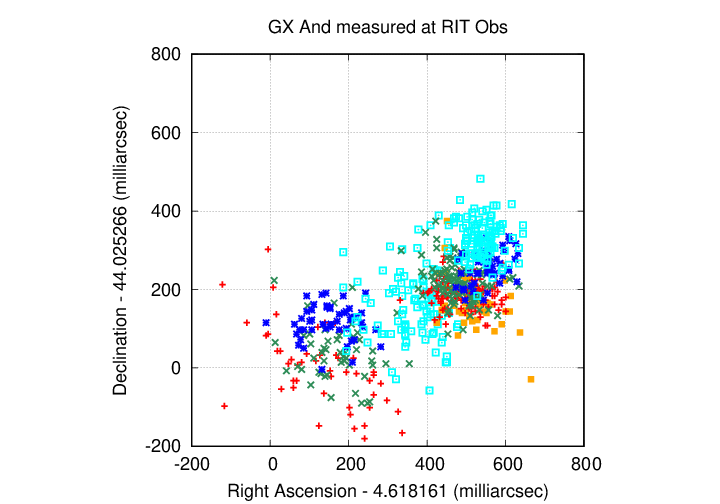
On the night of Jul 20/21, 2020, under fair conditions, I acquired images for astrometry of two nearby stars. One was Ross 248 , and the other GX And ; the latter is actually a double star, with two components separated by about 35 arcsec moving together.
I also just barely managed to see all six naked-eye planets at once; well, within seconds, as I had to turn around and look in opposite directions.
This is one of the stars that a capstone student may study over the next year in a project involving parallax. Ross 248 is a relatively faint red star surrounded by many other stars of similar brightness, so it's a good candidate for high-precision parallax measurements.
The main setup was:
Notes from the night:
The object is (currently) near position
RA = 23:41:55.27 Dec = +44:10:06.38 (J2000)
A chart of the field is shown below. The size of the chart is about 41 x 27 arcminutes. The noisy area at right (West) is the shadow of the guider's pickoff mirror.

I've marked the location of several comparison stars.
star UCAC4 B V r ------------------------------------------------------------------------- A UCAC4 671-120730 12.617 10.689 B UCAC4 671-120688 C UCAC4 671-120749 10.987 10.663 P kappa And 4.06 4.14 --------------------------------------------------------------------------
I took a photo of the finder TV's screen when pointing to Ross 248; this could be a useful reference for the future:

I ran the camera at the usual temperature of -20 C. Nothing out of the ordinary.

I took a series of 50 exposures of the field, using the R-band filter and an exposure time of 20 seconds.
Using the same techniques as described for earlier nights, I matched detected stellar positions to the Gaia DR2 catalog; as usual, I used a linear model and included all stars in the catalog.
I am continuing to use the box
cr=650 sc=1000 nr=1300 nc=1000mentioned in the entry for Jun 28, 2020 to avoid vignetting and coma.
This is my ninth measurement of Ross 248. The small hints of motion, negative in both directions, are consistent with the expected path of the object.

The dispersion of the derived positions was particularly small this evening. I believe that the measurements are improving because the field is now high in the sky when I observe it: tonight, its elevation was about 77 degrees!
Like Ross 248, GX And is a nearby (binary) star which will be the target of a parallax project in the coming year. One of the two components is bright -- about mag V = 8 -- so one must use short exposures to prevent it from saturating the detector. That may mean that this system isn't as easy to measure as Ross 248 or some others.
The object is currently close to this position:
RA = 00:18:28.4 Dec = +44:01:31 (J2000)
but it does have a very high proper motion.
A chart of the field is shown below. The size of the chart is about 41 x 27 arcminutes. The noisy area at right (West) is the shadow of the guider's pickoff mirror.

The two components of the GX And binary sit inside the box. I've marked the location of several comparison stars as well.
star UCAC4 B V r ----------------------------------------------------------- A 671-001473 9.939 9.790 B 670-001639 9.413 8.472 C 671-001509 12.712 11.421 11.001 -----------------------------------------------------------
I took a photo of the finder TV's screen when pointing to GX And; this could be a useful reference for the future:

I took two series of 50 exposures of the field, using the R-band filter and an exposure time of only 5 seconds.
Using the same techniques as described for earlier nights, I matched detected stellar positions to the Gaia DR2 catalog.
The target is clearly moving in the positive RA direction, as we would expect from its known (large) proper motion.

After finishing my observations of the parallax targets, I spent some time scanning the eastern horizon with binoculars. I wasn't able to see Comet NEOWISE, mostly because there was a layer of clouds over the lake, far to the north. Skies were a bit better to the northeast, so I watched carefully for Mercury.
Jupiter and Saturn were bright in the western sky, but as dawn approached, Jupiter moved lower and lower, heading for the trees. I had to stand in one particular location on the Observatory lawn in order to keep it visible in the notch in the treeline. Mars and Venus were easy to see, high in the South and in the East, respectively, but Mercury was scheduled to rise around 4:30 AM -- not long before sunrise. Meanwhile, the low cloud bank to the north started to drift to the East. Would I be able to see Mercury before Jupiter disappeared?
Fortunately, at 4:42 AM, I caught sight of Mercury between two thin layers of cloud, using binoculars. When I switched to my naked eyes, I could occasionally see it winking into view, as it moved through the clouds. I was JUST able to glimpse it while Jupiter was still above the horizon, so by turning in place I was able to see (from East to West)
These snapshots from Stellarium capture my experience pretty well. First, looking East:

And now to the West:

Note that when I spotted Mercury, it was (before extinction) apparent magnitude 0.4, and only about 3 degrees above the horizon. Jupiter, meanwhile, was only 5 degrees above the western horizon.
This might be the second time I've seen them all at once during my life. Cool!
Last modified 7/21/2020 by MWR.